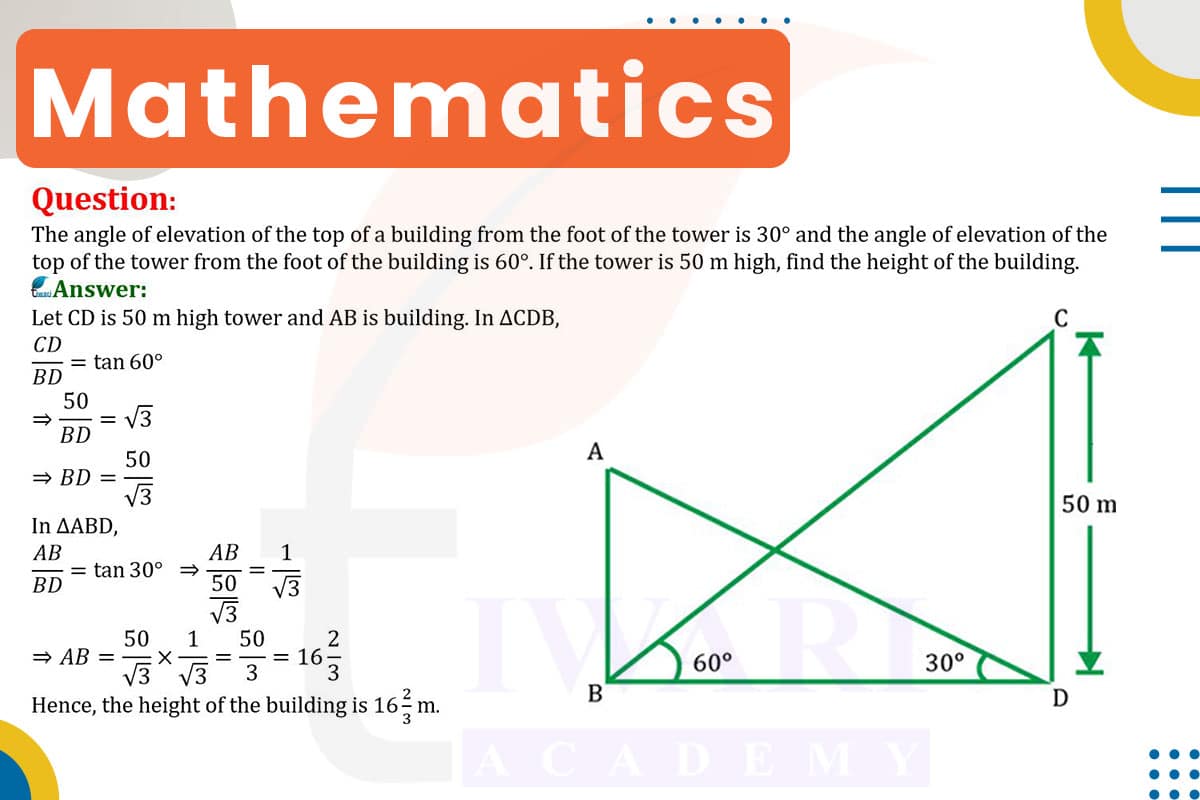To find the height of the building, we use trigonometry, specifically the tangent function. Let’s denote the height of the building as h and the distance between the building and the tower as d.
Angle of Elevation to Top of Tower (60°): Using tan(60°) = √3, the equation is √3 = 50/d. Solving for d, we get d = 50/√3.
Angle of Elevation to Top of Building (30°): Using tan(30°) = 1/√3, the equation is 1/√3 = h/d. Substituting d, we get 1/√3 = h/(50/√3).
Solving for h, we find h = 50/3, which is approximately 16.67 meters. Therefore, the height of the building is about 16.67 meters.

Let’s discuss in detail
Trigonometric Solutions in Architecture
Trigonometry, a branch of mathematics, plays a crucial role in architecture and construction, particularly in determining the heights of structures when direct measurement is not possible. The problem at hand involves finding the height of a building using the angles of elevation from the foot of a nearby tower and vice versa. This scenario is a classic example of how trigonometry can be applied to solve practical problems in architectural design and urban planning, demonstrating the utility of mathematical concepts in real-world applications.
Intersecting Lines of Sight
The problem presents two structures: a tower and a building. The angle of elevation to the top of the tower from the foot of the building is 60°, and the angle of elevation to the top of the building from the foot of the tower is 30°. The height of the tower is given as 50 meters. The objective is to determine the height of the building. This setup forms two right-angled triangles, one with the tower and one with the building, sharing a common horizontal distance.
The Role of Tangent in Angle of Elevation
In trigonometry, the tangent of an angle in a right-angled triangle is the ratio of the length of the opposite side (height of the structure) to the length of the adjacent side (horizontal distance between the structures). By applying the tangent function to the given angles of elevation, we can calculate the heights and distances involved in the problem.
Calculating the Distance Between the Tower and the Building
First, we calculate the distance between the tower and the building using the 60° angle of elevation to the top of the tower. The tangent of 60° is √3, so the equation is tan(60°) = (50 m)/d, where d is the distance. Solving for d, we find d = 50/√3 meters.
Determining the Height of the Building
Next, we use the 30° angle of elevation to find the height of the building. Applying tan(30°) = 1/√3, the equation is 1/√3 = h/d, where h is the height of the building. Substituting the previously calculated value of d, we get 1/√3 = h/(50/√3). Solving for h, we find h = 50/3 meters.
Trigonometry in Determining Building Heights
The height of the building, calculated to be approximately 16.67 meters, demonstrates the practical application of trigonometry in architectural and construction scenarios. This method is particularly useful in urban environments where direct measurement of heights can be challenging. Trigonometry not only provides a mathematical solution to these problems but also ensures accuracy and efficiency in planning and design. This scenario underscores the importance of trigonometry in real-life applications, bridging the gap between theoretical mathematics and practical problem-solving in the field of architecture.
Discuss this question in detail or visit to Class 10 Maths Chapter 9 for all questions.
Questions of 10th Maths Exercise 9.1 in Detail

